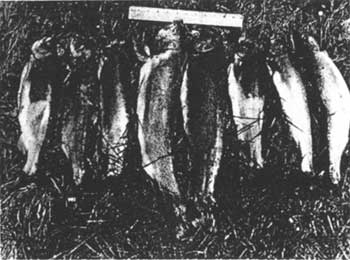How Fish Came to Crater Lake
“Were fish present in Crater Lake when it was discovered in 1853,” is a question frequently asked by visitors to the park, but apparently it is a query that will never be answered to the satisfaction of everyone.
John Wesley Hillman, discoverer of the lake, did not descend to the water, and thus made no observations concerning the existence of life within it. However, in 1865 a group of soldiers from Fort Klamath on a hunting expedition reportedly saw on the shores of the lake a hawk-like bird clutching a fish in its talons. Subsequent visitors to the lake between the years 1866 and 1888 failed to find any evidence that fish were present; so the belief has grown that Crater Lake was barren until rainbow trout were planted by Judge William G. Steel in 1888.
Nevertheless, it is interesting to speculate concerning the possible means by which fish might have gotten to Crater Lake providing we choose to accept the report as given by the soldiers that fish were present in the lake in 1865.
First, trout and allied species have been carried short distance by ospreys and other predacious birds. The author has seen a cutthroat trout survive such a forced trip of one-quarter mile in Yellowstone Park. However, distances from streams on the slopes of Mt. Mazama over the rim of the crater and down to the lake are so great that it is quite unlikely that such a transfer occurred.
It has also been proved that aquatic birds, such as gulls and pelicans, have occasionally carried fertilized fish eggs on their feet from one waterway to another; but in the case of Crater Lake such a transfer of trout eggs is only a remote possibility because the eggs of this group of fish are usually buried by the female several inches in the sand and gravel in the preparation of the redds or nests.
A third possibility is the presence of underground channels through which fish could have made their way from the headwaters of adjacent streams into the lake. It is possible that such direct channels do exist, but the likelihood of trout traversing such a waterway is very doubtful.
If fish were able to migrate through such underwater channels, it is likely that there would have been an interchange of fish between Emerald Lake, a small body of water on Wizard Island, and Crater Lake; for only a short distance separates the two lakes. The fact that the chemical composition and the water levels are identical and the fact that the rocks which separate the two bodies of water are large and piled in a haphazard fashion indicates that an exchange of water exists.
Throughout the world aborigines have frequently transferred fish to water situations which were more convenient for their angling activities. Indians certainly were present in the vicinity of Crater Lake for many years before the first white explorers and settlers came into the area, but it has never been proved that the Indians of Western North America ever engaged in the transplanting of fishes.
In addition to those methods enumerated there are several other ways by which fish have been carried from one waterway to another, such as waterspouts, tidal waves, etc., but the chances of such a transfer in the case of Crater Lake are again extremely remote.
On the other hand, we can choose to believe the more likely supposition that fish were absent in Crater Lake until artificially placed there by man in 1888. Because this transplant was made under unusual circumstances, conditions which illustrate the endurance and perseverance of the western pioneers, the facts will bear repeating.
Believing that fish life would add to the attractiveness of Crater Lake, Judge Steel persuaded a friend who lived on the Rogue River, forty-five miles from Crater Lake, to supply him with fingerling rainbow bout. Several hundred were placed into a large bucket, covered with cloth, and stowed in a wagon. It eventually became necessary for the Judge to carry the bucket the forty-odd miles to the lake, for the rough road caused the water to slosh out of the pail. At creeks enroute he refilled the container with fresh water and during the night was very careful to protect the fish from harm.
Upon arriving at the crater rim Judge Steel was greatly disappointed to find that most of the small trout were dead. In an effort to save the remainder which showed signs of life, the Judge carried the bucket down the precipitous slope of the crater wall and released 37 trout into the lake. These fish apparently prospered, for tourists who came to the lake during the following years reported that rainbow trout were present in the lake, trout which they believed were the same offspring of the individuals Judge Steel had planted.
Since 1888 over a million have been planted in Crater Lake. Very few of these have been taken, but they and their progeny have added pleasure to many fishermen who have visited the park.


